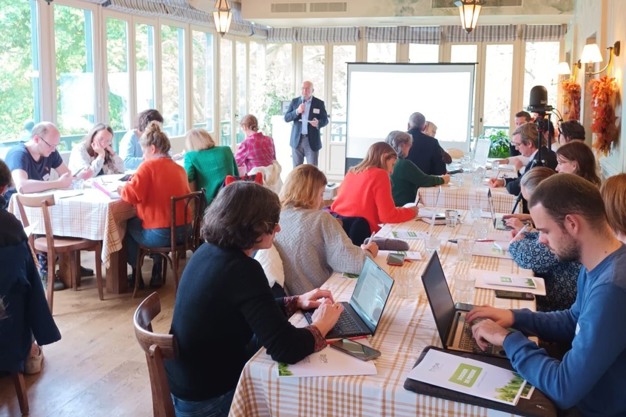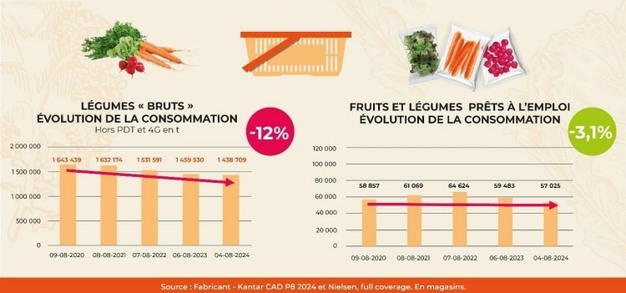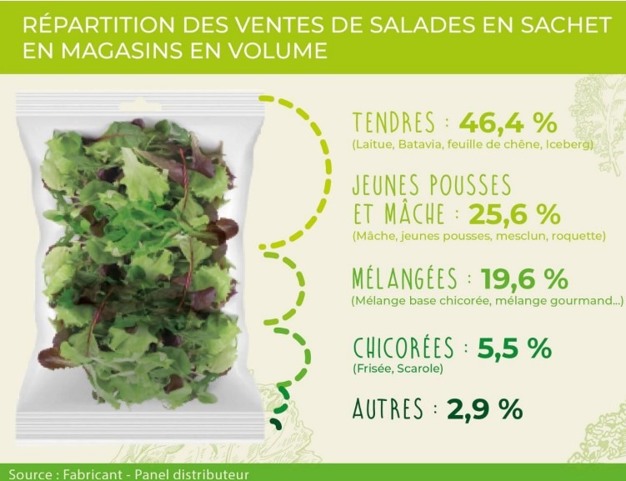"Since the first products hit the shelves in the early 80s, ready-to-eat fresh salads and vegetables have gradually become an everyday staple. The French market has seen volumes multiply by almost 5 in 30 years. In 2023, France produced almost 109,000 tons of ready-to-use fresh salads, vegetables and aromatic herbs, 80% of which were marketed in bags," according to the Union of Manufacturers of Ready-to-use Fresh Produce (SVFPE) during a press conference held on November 12th. On the agenda: the place of ready-to-use fresh vegetables in the daily lives of the French and the drafting of a corporate social responsibility charter to "reinforce responsible practices."
 SVFPE
SVFPE
2024: ready-to-use fresh vegetables withstand the general decline in consumption in stores*
While purchases of raw vegetables in bulk have dropped in stores (-12%) over the first 8 months of the last 4 years, purchases of ready-to-use vegetables only lost 3% of their sales over the same period. More than 7 out of 10 French people buy fresh salads and vegetables in bags (Nieslen panel). 72% of French consumers buy ready-to-use vegetables. With more than 1 purchase per month, this consumption represents 14 bags per year per buyer.

Bagged salads form the majority: 350 million bags in 2023 (source: SVFPE 2023 - volumes sold by companies). In 2023, the global ready-to-use vegetables market represented a total of almost 109,000 tons of packaged raw vegetables, including more than 87,000 tons of bagged salads, which is 80% of the market. For salads, the volumes offered on the entire market (home + out-of-home) in 2023 will represent the equivalent of around 350 million bags of 250g. In 2023, ready-to-use vegetables generated sales of almost €421 million [442 million USD], including almost €357 million [374 million USD] for bagged salads.

Lettuce number 1 in volume sales. The majority of bagged salads sold in shops are 'soft', lettuce-type salads. They currently account for 46.4% of volumes sold in shops. Source: Manufacturer - 2024 distributor panel
Reasons for buying and criteria for choice?
Convenience, time-saving and availability are the main reasons given for buying ready-to-use salads. Shoppers agree first and foremost that they are convenient and ready to use (64%, +4 pts vs. 2021) and that they save time (55%). In third place, buyers mention the fact that they can find their favourite salads all year round (40%, +10 points in 3 years), followed by the fact that they can be easily stored in the fridge (37%, +9 points vs. 2021), a reason they rank alongside the advantage of having several varieties in a single bag (37%, +6 pts vs. 2021). The possibility of finding varieties not available in the traditional fresh produce section is cited by 32% of buyers (+9 pts in 3 years), while the possibility of keeping them for longer than loose salads (28%, +6 pts) is mentioned as much as the fact that ready-to-use salads are as good as traditional salads (28%, +4 pts).
Variety, appearance and pack size: the three main criteria for choice. To select their bagged salads, two thirds of shoppers (66%) base their choice on the variety of salad they fancy. Then, 56% look at its appearance for freshness, and almost equally, 55% make their choice according to the size of the bag (+12 pts vs 2021). The fourth choice criterion concerns 49% of buyers, who are interested in the shelf-life printed on the packaging. It is almost on a par with price, mentioned by 48% of buyers (+10 points in 3 years).
Drawing up a charter formalizing commitments in terms of social responsibility (pesticides, water, packaging)
The sector wants to formalize its commitments to social responsibility through a charter. To this end, the various working groups have defined indicators to quantify the progress made by professionals in reducing their impact on the environment. Data is being collected on the reduction of plant protection products, water management and packaging recyclability.
The survey on sustainable cultivation practices shows that all of its members have
put in place strict specifications with their producers, including a section dedicated to specific requirements on the control of phytosanitary products. In addition, 92% of salad suppliers are GLOBAL GAP certified. Other certifications are also involved: HEV (High Environmental Value), organic, Leaf (Linking Environment And Farming), Planet Proof... The changes in cultivation practices over the last ten years also reflect a trend towards more sustainable methods: biocontrol, insect trapping, choosing varieties that are more robust to climate conditions, lengthening crop rotations and using organic matter, plant cover, hoeing, false seeding, mulching or manual weeding.
Regarding water management, the survey shows significant progress in reducing water withdrawals (-30% between 2019 and 2023) and improving the water efficiency of ready-to-use plant preparation workshops. Detecting losses in pipe circuits is also one of the actions taken in the workshops. Meters have been installed at points of use, along with alarm systems to detect leaks and abnormal consumption. Finally, 58% of sites now have a Water Saving Plan.
In terms of packaging, professionals want to act on the reduction and recyclability of plastic packaging. To this end, the size and thickness of bags has been reduced (by more than 20% in 5 years, from 40-45 microns to 30-35 microns), recyclable bags have been deployed, and bio-based plastic is used. Today, almost 100% of packaging for these products is recyclable. The recycling chain for flexible packaging, which will eventually be 100% recyclable, is currently being developed and should be operational in the first half of 2026.
